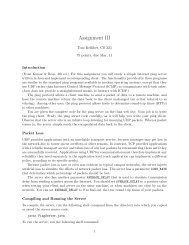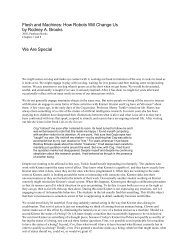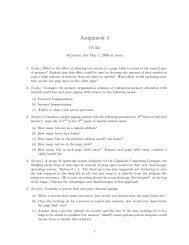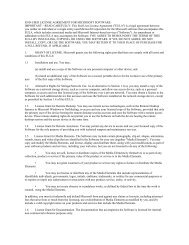Characteristics of Packet-Switched Networks ... - Phoenix Goucher
Characteristics of Packet-Switched Networks ... - Phoenix Goucher
Characteristics of Packet-Switched Networks ... - Phoenix Goucher
You also want an ePaper? Increase the reach of your titles
YUMPU automatically turns print PDFs into web optimized ePapers that Google loves.
<strong>Characteristics</strong> <strong>of</strong> <strong>Packet</strong>-<strong>Switched</strong> <strong>Networks</strong>; Protocols<br />
1 Administrivia<br />
Announcements<br />
Assignment<br />
Read 2.1–2.3.<br />
From Last Time<br />
The Internet’s edge and core.<br />
Outline<br />
Tom Kelliher, CS 325<br />
Jan. 31, 2011<br />
1. <strong>Packet</strong>-<strong>Switched</strong> network characteristics.<br />
2. Protocol layers and models.<br />
3. Security.<br />
4. History<br />
1
Coming Up<br />
Introduction to application layer, HTTP and FTP.<br />
2 <strong>Packet</strong>-<strong>Switched</strong> Network <strong>Characteristics</strong><br />
2.1 Delay<br />
<strong>Packet</strong> transmission delay model:<br />
Nodal delay (one switch):<br />
Delay components:<br />
dnodal = dproc + dqueue + dtrans + dprop<br />
1. Processing delay: integrity checking, routing, etc.<br />
2. Queuing delay: Waiting in output buffer prior to transmission. Variable.<br />
3. Transmission delay: Getting the entire packet “out the door.”<br />
Let packet contain L bits and link transmission rate be R b/s. Transmission delay is<br />
then L/R.<br />
2
4. Propagation delay: Time for one bit to traverse the medium between two switches.<br />
End-to-end delay with n switches along the route:<br />
n<br />
i=1<br />
dnodali<br />
Using traceroute to see the route between two hosts:<br />
bluebird:~<br />
% traceroute www.google.com<br />
traceroute to www.google.com (64.233.169.147), 30 hops max, 40 byte packets<br />
1 10.67.1.1 (10.67.1.1) 1.383 ms 1.552 ms 1.674 ms<br />
2 66.240.10.65 (66.240.10.65) 30.927 ms 232.192 ms 250.335 ms<br />
3 at-8-0-0-16-br01.whm.comcastcommercial.net (66.240.7.165)<br />
67.405 ms 122.690 ms 140.896 ms<br />
4 ge-6-0-cr01.whm.comcastcommercial.net (208.39.140.9)<br />
49.226 ms 85.665 ms 104.371 ms<br />
5 ge-5-2-113.hsa1.Baltimore1.Level3.net (4.78.140.13)<br />
159.112 ms 177.257 ms 195.600 ms<br />
6 so-6-1-0.mp1.Baltimore1.Level3.net (4.68.112.65)<br />
213.743 ms 257.386 ms 266.623 ms<br />
7 ae-2-0.bbr1.Washington1.Level3.net (4.68.128.201)<br />
275.783 ms 249.083 ms 247.324 ms<br />
8 ae-1-69.edge1.Washington1.Level3.net (4.68.17.16) 238.350 ms 229.374 ms<br />
ae-3-89.edge1.Washington1.Level3.net (4.68.17.144) 219.795 ms<br />
9 GOOGLE-INC.edge1.Washington1.Level3.net (4.79.228.38) 210.880 ms<br />
GOOGLE-INC.edge1.Washington1.Level3.net (4.79.231.6) 202.249 ms<br />
GOOGLE-INC.edge1.Washington1.Level3.net (4.79.228.38) 193.167 ms<br />
10 64.233.175.169 (64.233.175.169) 184.294 ms<br />
64.233.175.171 (64.233.175.171) 175.361 ms 166.344 ms<br />
11 72.14.232.21 (72.14.232.21) 157.196 ms 10.448 ms 160.945 ms<br />
12 yo-in-f147.google.com (64.233.169.147) 26.664 ms 6.023 ms 16.402 ms<br />
BTW, Level 3 is a Tier 1 ISP.<br />
2.2 Queuing Delay and <strong>Packet</strong> Loss<br />
If packets arrive more quickly at the switch than we can send them, we have a couple<br />
problems:<br />
3
1. <strong>Packet</strong>s will begin to queue up in the switch’s buffers — increasing queueing delay.<br />
2. If the buffer fills completely, packets will be dropped — lost forever.<br />
Traffic intensity is a metric used to describe queuing delay:<br />
where a is the packet arrival rate, per second.<br />
2.3 Throughput and Latency<br />
Two throughput measures:<br />
La<br />
R ,<br />
1. Instantaneous throughput — throughput at a particular instant.<br />
2. Average throughput.<br />
Transferred 5 MB MP3 file in 12 sec.: (5∗2 20 ∗ 8)/30 = 1.4 mb/s.<br />
4
The “slowest” link determines the overall throughput — the bottleneck:<br />
Internet resources are shared:<br />
Latency: How long it takes the first bit to make it from end-to-end.<br />
Rules <strong>of</strong> thumb:<br />
1. Latency matters for realtime applications: gaming, telephony. Throughput may or<br />
may not matter — low-fi audio, no; video, yes.<br />
2. Throughput usually matters for file transfer.<br />
5
3. Neither particularly matter for email; maybe IM.<br />
3 Protocol Layers and Models<br />
Protocols (services) are layered on top <strong>of</strong> each other:<br />
<strong>Characteristics</strong>:<br />
1. Only the physical layers on two hosts communicate directly.<br />
2. Higher layers communicate through lower layers — abstraction.<br />
Think <strong>of</strong> two heads <strong>of</strong> state communicating through their ministers, and the ministers<br />
communicating through under-secretaries.<br />
3. Going down, layers add headers with information specific to that layer (nested envelopes).<br />
6
4. Going up, layers examine and discard headers.<br />
Layer synopses:<br />
1. Application layer: What ordinary think <strong>of</strong> the Internet as: HTTP, SMTP, FTP, etc.<br />
Unit <strong>of</strong> exchange: message.<br />
2. Transport layer: message transport service between hosts.<br />
(a) TCP: connection-oriented service; guaranteed delivery; segmentation <strong>of</strong> messages;<br />
congestion control.<br />
(b) UDP: connectionless service; delivery not guaranteed; no congestion control.<br />
Unit <strong>of</strong> exchange: segment.<br />
3. Network layer: segment delivery service.<br />
IP protocol. No guarantee <strong>of</strong> delivery. Routing services occupy this layer.<br />
Unit <strong>of</strong> exchange: datagram.<br />
4. Link layer: delivery <strong>of</strong> datagrams between two adjacent nodes.<br />
Sometimes delivery is guaranteed. The mediums between links may vary.<br />
Unit <strong>of</strong> exchange: frame.<br />
5. Physical layer: move frames from one node to the next.<br />
Unit <strong>of</strong> exchange: bit.<br />
7
TCP/IP example:<br />
4 Security<br />
The “bad guys” can:<br />
1. use viruses, worms, malware on web sites, etc. to take control <strong>of</strong> hosts.<br />
Botnets — “148,000 hosts added to botnets daily.”<br />
8
2. attack Internet infrastructure. DDOS attack:<br />
3. Read, modify, or delete packets.<br />
4. Masquerade as legitimate hosts.<br />
Hosts files, DNS cache poisoning attacks.<br />
5 History<br />
1. The original “Internet” in 1969 consisted <strong>of</strong> four nodes.<br />
9
Today? Reachable hosts according to the Internet Systems Consortium:<br />
This is a gross undercount.<br />
10
2. An early IMP (router):<br />
3. A modern “router,” the Linksys WRT54GL:<br />
11










